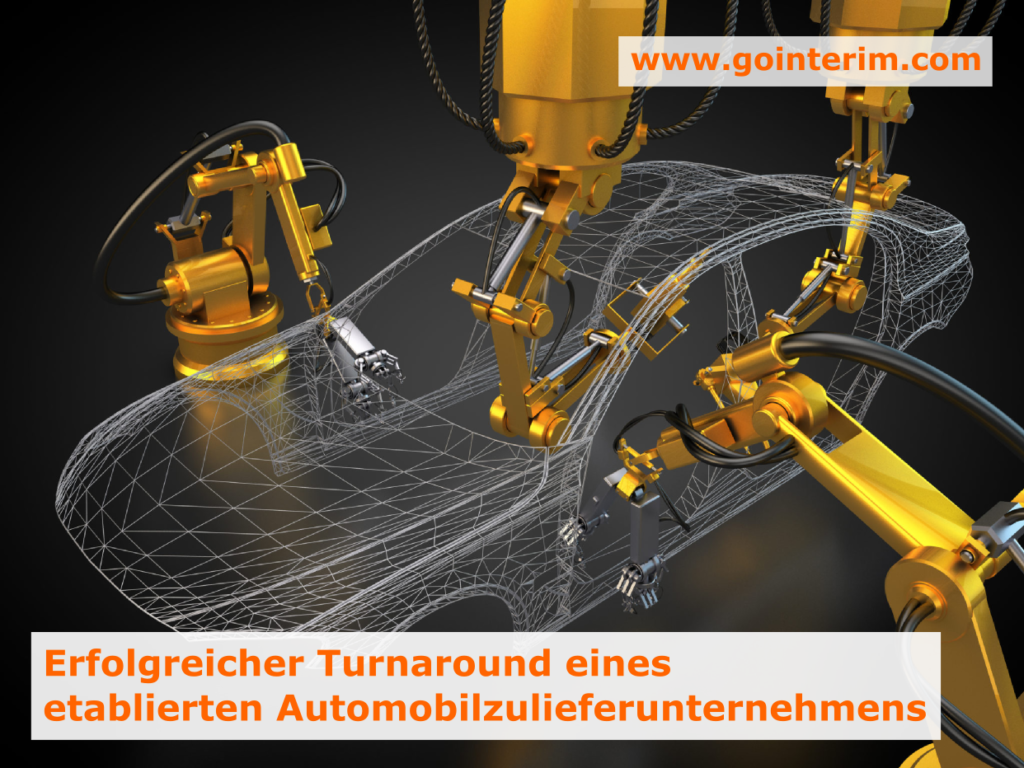Successful turnaround of an established automotive supplier company

Introduction:
The company has increasingly lost its market position in recent years. Cost structures are inefficient, production processes are not optimized, and there is an oversupply of employees. In addition, the company is struggling to raise sufficient funds to cover its ongoing operating costs and to make the necessary investments in new technologies and product development.
The measures included more efficient organization, cost reduction, personnel adjustments, securing sufficient financial resources and developing a new strategic direction. The restructuring resulted in a leaner organization with shorter decision-making paths and improved communication flows. Costs were significantly reduced, resulting in financial stability and improved cash flow. Staff adjustments optimized headcount and improved employee retention and motivation. Securing sufficient funding enabled investments and covered ongoing operating costs. Finally, the strategic realignment led to an improved competitive position through the integration of electric vehicles and other sustainable mobility solutions.
Overall, the interim management project enabled a successful restructuring and strategic realignment. This enabled the company to restore its competitiveness and achieve sustainable growth.
Company:
The client is an established automotive supplier, Tier 1, with an international focus, facing a challenging economic environment with declining sales and high costs. The company was struggling to adapt to changing market conditions and urgently needed an experienced CRO to restructure, as well as strategically refocus.
Measures and implementation steps:
- Restructuring of the organization:
The interim CRO (Chief Restructuring Officer) is tasked with conducting a comprehensive analysis of the existing organizational structure and identifying more efficient processes. He develops a detailed restructuring plan that includes eliminating redundant hierarchies, merging departments and introducing a leaner decision-making process. - Cost Reduction:
The interim CRO reviews all operational cost areas and identifies potential savings. Introduces a cost-cutting initiative that includes a review of supplier contracts, optimization of inventory management, and reduction of energy and material costs. - Staffing Adjustment:
The interim CRO analyzes the company’s workforce structure and develops a workforce adjustment plan. This involves reducing the number of employees through natural attrition, early retirement and, where appropriate, redundancies. At the same time, he introduces employee motivation and retention measures to boost morale and productivity. - Funding:
The Interim CRO is responsible for ensuring adequate funding. He reviews the existing financing structure and develops a plan for optimizing working capital, negotiating loan agreements, and tapping new sources of financing, such as investors or government funding programs. - Strategic realignment:
The interim CRO supports the company in developing a new long-term strategy. He conducts a comprehensive market and competitive analysis, identifies growth opportunities and develops new product and market entry strategies. It also takes into account the increasing importance of electric vehicles and other sustainable mobility solutions.
Results:
By implementing the Interim CRO’s actions and projects, the company achieves the following results:
- More efficient organization:
The restructuring of the organization leads to a leaner and more agile corporate structure. Decision-making paths are shortened, communication is improved and synergies between departments are exploited. - Cost Reduction:
By implementing cost reduction measures, the company succeeds in significantly reducing its operating costs. This leads to improved financial stability and cash flow. - Staffing Adjustment:
The workforce adjustment measures result in an optimal number of employees and a better alignment of employees with the strategic goals of the company. At the same time, employee motivation and loyalty increase, leading to higher productivity and quality. - Financing security:
By implementing an optimized financing concept, the company secures sufficient financial resources to cover its ongoing operating costs and make necessary investments. This enables the company to implement its growth strategy. - Strategic realignment:
The company is developing a new long-term strategy based on current market trends and future developments. By introducing electric vehicles and other sustainable mobility solutions, the company can strengthen its competitive position and exploit new market opportunities.
Overall, the interim management project enabled the international group of companies to successfully restructure and realign its strategy. This will enable the company to restore its competitiveness and achieve sustainable growth. The turnaround was thus successfully implemented!
